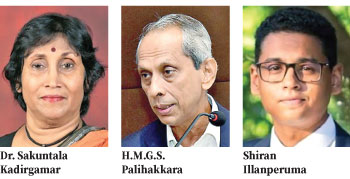As global power dynamics undergo rapid and unpredictable changes, Sri Lanka finds itself, again, at a strategic crossroad. In a world marked by the shifting gravity of economic power, rising regional blocs, and intense rivalry between China and the US, Sri Lanka is grappling with questions it has been dealing with since Independence: should it align, hedge, or assert a “middle path” in the face of these changes? And what lessons, if any, do its proud legacy of non-alignment offer as it faces an uncertain future?
These questions took centre stage at a recent panel discussion titled, ‘Foreign Policy in Times of Crisis: Lessons from Bandung,’ organised by the Bandaranaike Centre for International Studies (BCIS) on May 28.
Drawing from decades of diplomatic experience and scholarship, speakers revisited Sri Lanka’s non-aligned history and debated its relevance for today’s complex and turbulent international environment.
 The world is undergoing profound changes. With the economic and scientific development of China, and with the resurgence of resource rich Russia as an industrial powerhouse, the world is no longer unipolar. As the US and China are competing against each other, smaller nations such as Sri Lanka are being pressured to pick a side.
The world is undergoing profound changes. With the economic and scientific development of China, and with the resurgence of resource rich Russia as an industrial powerhouse, the world is no longer unipolar. As the US and China are competing against each other, smaller nations such as Sri Lanka are being pressured to pick a side.
This is not the first time countries such as Sri Lanka had been pressured to pick a side. The Global South was a battleground between the US and Soviet Union during the Cold War. The Non-Aligned Movement helped newly independent countries across Asia, Africa, and Latin America to resist pressure from the United States and the Soviet Union to pick sides in their global rivalry.
The 1955 Bandung conference in Indonesia, encouraged nations of the Global South to chart an independent path, prioritising sovereignty, solidarity, and peaceful cooperation. Today, as tensions intensify between the US and China, the lessons of Bandung and the principles of non-alignment may help the Global South to protect their interests and autonomy in an era of renewed great power competition.
The resource persons at the panel discussion ‘Foreign Policy in Times of Crisis: Lessons from Bandung,’ organised by the BCIS were former Secretary to the Ministry of Foreign Affairs and former Governor of the Northern Province, Ambassador H.M.G.S. Palihakkara and a political economist at Tricontinental, Shiran Illanperuma. The discussion was moderated by Executive Director of the Law and Society Trust, Dr. Sakuntala Kadirgamar.
Former Secretary to the Ministry of Foreign Affairs and former Governor of the Northern Province, Ambassador H.M.G.S. Palihakkara said, “Today’s reflection on Bandung occurs at a time of profound national and international change, a mixed bag of uncertainties, dangers, and imponderables. Many contend that these changes threaten the globalised system to which we have become accustomed, producing anxiety over unpredictability and instability. Some, however, say that these are simply the labour pains of a new multipolar world.”
For Sri Lanka, the consequences of these changes are felt in every domain, from economic recovery to national security. The post-World War II “rules-based order,” once the bedrock of international affairs, is now under challenge, mainly due to the actions of the US who played the key role in setting these rules following the Second World War.
While the system is said to be governed by rules, “in practice it is largely power based, with power generally trumping rules when they conflict.” In this environment, countries such as Sri Lanka find their policy space and capacity for sustainable growth increasingly constrained, forced to “balance the unbalanceable” as competing global interests pull them in multiple directions.
Nowhere is this more illustrated than in the Indo-Pacific, a region Ambassador Palihakkara described as “one of broad contradictions: prosperity coexists with insecurity, while rising military expenditure and ability produce new flashpoints.” Here, Sri Lanka’s geographical location becomes both its greatest asset and challenge, needing deft diplomacy and strategic caution.
The dilemma of alignment versus autonomy
At the heart of Sri Lanka’s foreign policy debate lies a crucial question: should the country integrate asymmetrically with a rising India and the robustly growing Indian economy, as some suggest, or should it cling to the principles of non-alignment and strategic autonomy, even as regional power rivalries intensify? The issue is not abstract, but practical, involving questions of security, energy independence, and the sovereignty of public policy-making.
Ambassador Palihakkara summarised the contending positions, “Some say that Sri Lanka should closely align its economy with India, hoping to benefit from India’s rapid growth, even if it means abandoning a non-aligned foreign policy. However, others warn that such alignment could threaten Sri Lanka’s real independence in key areas such as security, energy, and public policy, making the country overly dependent and undermining its sovereignty.”
Both sides of the debate are vocal, but, as Palihakkara said a vital “middle path” is often overlooked. This would involve addressing Indian security concerns through clear bilateral arrangements while simultaneously deepening and widening economic cooperation in mutually beneficial areas, without ceding structural control or autonomy.
A new era of pragmatic non-alignment?
What, then, is the relevance of non-alignment in a world where the old Cold War certainties have dissolved and a new, messier multipolarity has taken their place? Is the Non-Aligned Movement (NAM) now, as one academic memorably put it, “a moribund organisation in need of a decent burial”? Or does it possess renewed utility in an age of transactional diplomacy, where even the most powerful nations avoid exclusive alliances?
Evidence from across Asia suggests that non-alignment, or at least strategic autonomy, is far from obsolete. Singapore’s Foreign Minister, for example, has articulated a posture of not wanting to be accused of being on the wrong side of any power rivalry, simply because “we want to benefit from all sides.” India’s Foreign Minister, Dr. S. Jaishankar, has said repeatedly that India is a strategic partner of the U.S. in identified areas, but is not an ally of the U.S. India participates in groupings such as the Quad, but has not joined more formal security alliances such as AUKUS, and continues to pursue cooperation with China even amid tensions.
Ambassador Palihakkara characterised this as “a very sophisticated non-aligned argument for non-alignment.” The aim is to “shun power rivalries which a country does not like, but exploit other contestations that can bring benefits.” For Sri Lanka, with its strategic location and historic commitment to diplomatic flexibility, such an approach holds particular appeal.
Non-alignment, from Bandung to today
To understand why non-alignment retains such allure in Sri Lanka, it is essential to look back at its legacy within the movement. Sri Lanka, then Ceylon, played a pivotal role in the Non-Aligned Movement’s formative decades. The 1976 Summit in Colombo was seen as a national event of singular significance, executed in an era of economic austerity, rationing, and limited resources. Yet, the country pulled off the event with efficiency and discipline. There were no fleets of luxury vehicles; dignitaries stayed in modest accommodation, and even the ushers wore locally manufactured nylon saris chosen to suit all skin tones.
Executive Director of the Law and Society Trust, Dr. Sakuntala Kadirgamar said Sri Lanka’s leadership on issues such as the Convention on the Law of the Sea was another highlight of this era. As a small State, Sri Lanka played a disproportionate role in shaping the NAM and the broader agenda of the global South. “It was a national event like no other,” Kadirgamar recalled. “Leaders such as Indira Gandhi, Fidel Castro, Muammar Gaddafi, Anwar Sadat, and Marshal Tito attended the summit, and the respect and admiration they showed Sirimavo Bandaranaike was remarkable.”
The close of the 1970s, however, saw Sri Lanka pivot sharply away from non-alignment. After the electoral defeat of Bandaranaike in 1977, the Government of J.R. Jayewardene embraced a Western capitalist model, believing that economic and other alliances with the United States and its partners would bring investment, technology, and markets.
Reviving the spirit of Bandung
A political economist attached to the Tricontinental: Institute for Social Research, Shiran Illanperuma, said that while mass mobilisation and political subjectivity have waned in the global South, objective conditions are changing. “Since the 2008–09 financial crisis, there is growing recognition in the Global South that dependence on the Global North cannot continue indefinitely.” This has prompted the formation of new blocs such as BRICS, with their own diverse and often competing interests.
Sri Lanka, Illanperuma said, has a tradition within the non-aligned and Third World movement that positions it to make positive contributions, particularly in areas such as global peace advocacy and debt cancellation. “Joining international processes today is not just a matter of bandwagoning with a major global South power; it is about articulating our own national interests and integrating them with projects such as BRICS, SAARC, or the Shanghai Cooperation Organisation (SCO).
Specifically, Sri Lanka can contribute to the global peace movement, given the intensification of conflicts, such as India-Pakistan, Ukraine–Russia, and the militarisation of the Indo-Pacific, and on debt cancellation, given our own situation and the broader criticisms of debt restructuring.”
For Sri Lanka, the challenge is to avoid being drawn into exclusive alliances or becoming a “tributary state” to any single power, while at the same time leveraging its geographic location, diplomatic capital, and historic commitment to multilateralism. The lessons of non-alignment, flexibility, creative diplomacy, and moral leadership remain as relevant now as ever.








